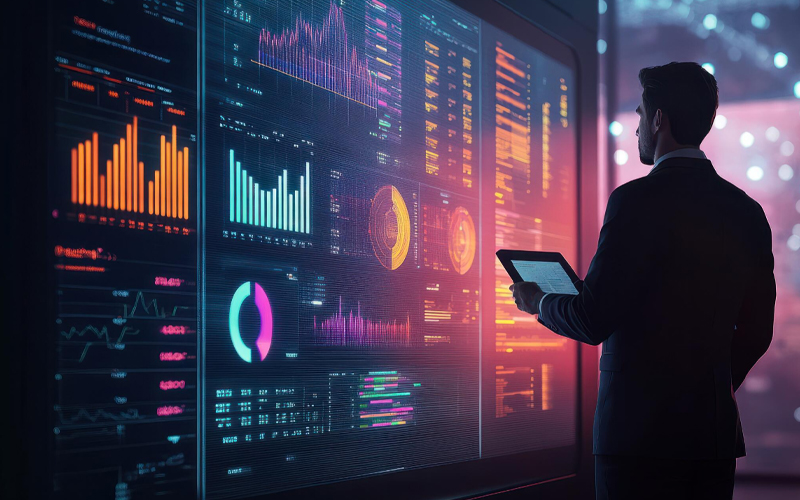In a digital-first world of 2025, driven by innovations in AI, the darker shadow of increasingly sophisticated threats looms large over businesses. Trust and Safety strategies act as the unseen backbone of any enterprise, critical for maintaining integrity and accountability. However, a recent survey revealed that 63% of Trust and Safety professionals find keeping ahead of emerging threats to be one of their biggest challenges. Consequently, there is an urgent need to move from reactive moderation to proactive Trust and Safety strategies, such as predictive analysis and real-time monitoring.
real-time monitoring
Real-time monitoring involves the continuous, instantaneous collection, analysis, and reporting of data or events as they occur, with minimal latency between the event occurrence and the data processing. It is a proactive approach to risk mitigation, enabling businesses to detect anomalies, performance degradation, or critical incidents rapidly.
Real-time monitoring systems vary across use cases and industries. However, the process typically involves several stages:
- Data collection: Capturing data in real-time from logs, metrics, traces, and other sources using automated agents.
- Data transmission: Transferring collected data promptly to centralised monitoring systems, sometimes via intermediary processing tools.
- Data processing: Transforming collected data into a structured form using parsing, filtering, and data wrangling tools.
- Data analysis: Identifying trends, anomalies, or performance issues through immediate and automated analysis using AI or machine learning algorithms.
- Alerting: Generating instant notifications via communication channels when critical events or issues are detected.
- Visualisation and Reporting: Creating dashboards and reports with charts, graphs, and other visual tools to provide clear, actionable insights.
- System adaptation: Regularly updating monitoring tools and processes to reflect evolving requirements, ensuring continuous operational effectiveness.
- Continuous improvement: Optimising the monitoring system based on historical data and evolving business needs, allowing continuous refinement and responsiveness as demands change.
real-time monitoring benefits for businesses
In 202ss, the average cost of a data breach was a staggering US$4.88 million. Real-time monitoring systems provide immediate data insights that help in the rapid detection and resolution of breaches, fraud and incidents. Here are the key benefits of real-time monitoring:
- Faster and better decisions: Real-time insights enable IT teams to identify and resolve issues quickly, supporting more informed and faster decisions.
- Trend tracking: Regular data collection helps businesses stay in the know by easily spotting patterns and catching any unusual activities early, making it easier to respond promptly and effectively.
- Enhanced security: Live data monitoring quickly detects threats such as unauthorised access or breaches, ensuring system safety.
- Optimal network performance: Continuous monitoring process instantly identifies bottlenecks or latency problems, allowing proactive network optimisation.
- Improved productivity and operational efficiency: A smoothly performing system ensures employees have seamless application access, thus optimising workflows and efficiency.
- Cost savings: Early detection of issues prevents costly downtime and unnecessary maintenance expenses by helping detect and address potential problems before they become a money-draining exercise.
- Regulatory compliance: Immediate monitoring flags compliance-related issues, ensuring businesses stay within regulatory standards.
- Proactive incident management: Instant alerts help teams quickly resolve issues and act before incidents spiral out of control. Minimal disruptions for end-users enhance customer trust, satisfaction, and loyalty.
where real-time monitoring works in the real world
Real-time monitoring is no longer confined to security operations. It is now a core enabler of trust, compliance, and resilience across industries. Some of the key AI and non-AI enterprise use cases are as follows:
AI use cases: With the growing adoption of generative AI across various sectors, real-time monitoring offers several use cases to address trust and safety concerns. Gartner’s research says that 80% of emerging risks in their survey were attributed to AI-enhanced malicious attacks. From deepfakes to biases, hallucinations and misinformation, generative AI is notorious for eliciting trust and safety issues. Real-time monitoring can ensure the responsible deployment of AI-enabled processes. Moreover, monitoring data privacy compliance and identifying potential misuse scenarios is possible through a well-integrated real-time monitoring system.
Non-AI use cases: Outside of AI, real-time monitoring delivers value across enterprise operations.
- Cybersecurity: Live data monitoring enables the instant detection of unusual activity, such as unauthorised access or suspicious file movements, allowing organisations to act before breaches escalate.
- Compliance: For compliance teams, real-time monitoring helps enforce frameworks such as GDPR, HIPAA, and SOX by flagging policy violations or data breach attempts as they occur.
- E-commerce and financial sectors: Real-time monitoring systems guard against fraudulent activities, such as bot traffic, fake account creation, and geographically mismatched transactions, which can be identified and blocked in real-time.
- User-generated content: Real-time content moderation tools can enable platforms to manage hate speech, impersonation, and brand misuse.
- Healthcare: In healthcare, monitoring systems support patient safety by tracking vitals, alerting staff to equipment malfunctions, and ensuring that access to electronic health records is tightly controlled.
- Supply chains: Supply chains rely on real-time tracking for cold storage integrity, fleet safety, and shipment traceability to achieve time and cost savings.
how can Infosys BPM help
Infosys BPM offers proven Trust and Safety solutions across industries, like e-commerce, gaming, media, BFSI, and healthcare. With deep expertise in AI and digital transformation, we help businesses protect users, stay compliant, and build safer digital experiences. Connect with us to strengthen your trust and safety strategy.








